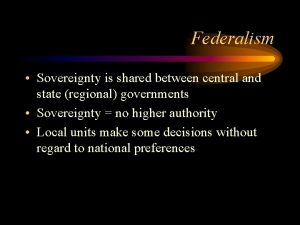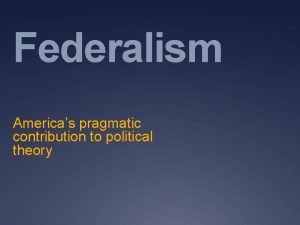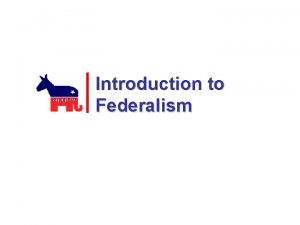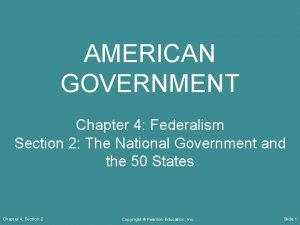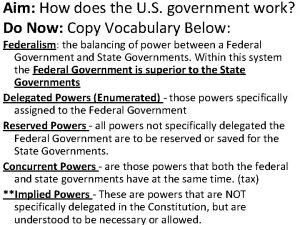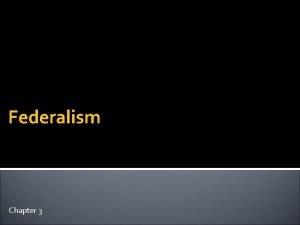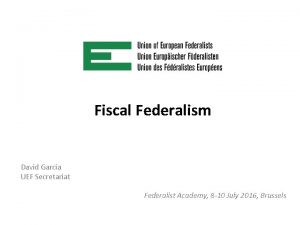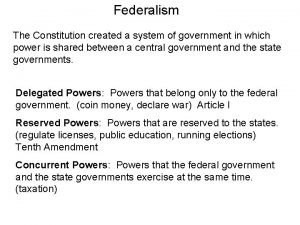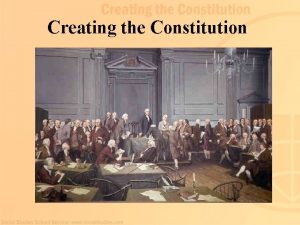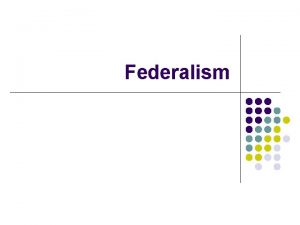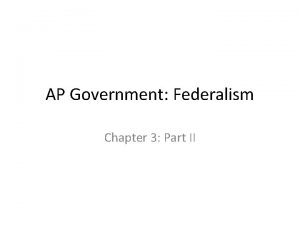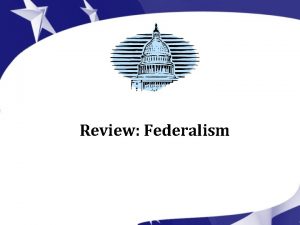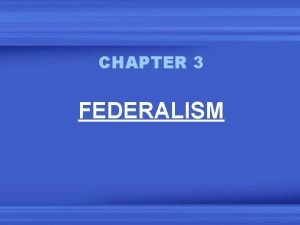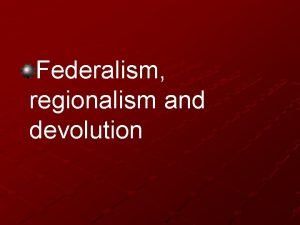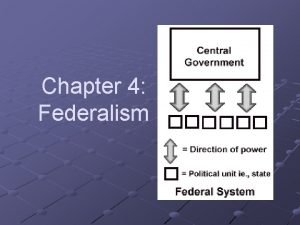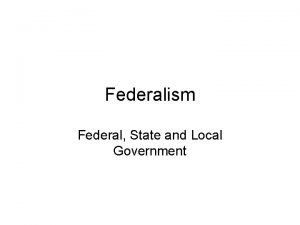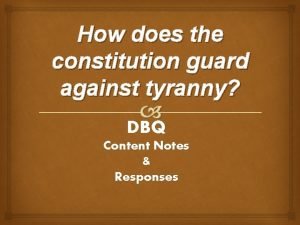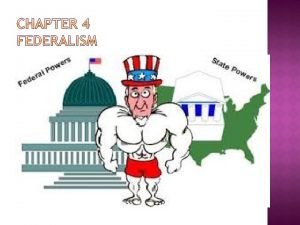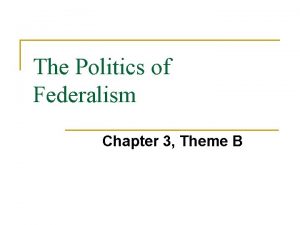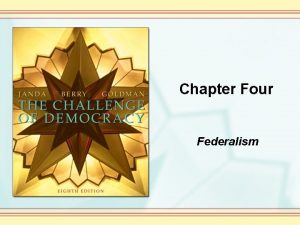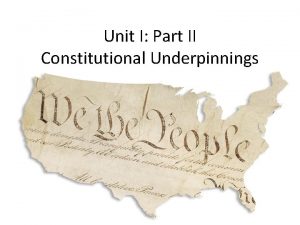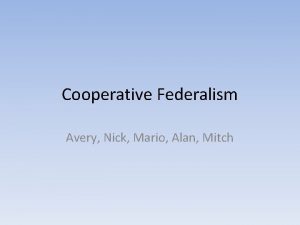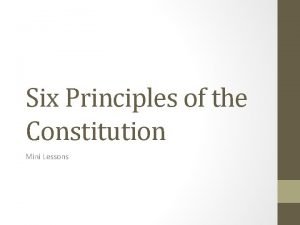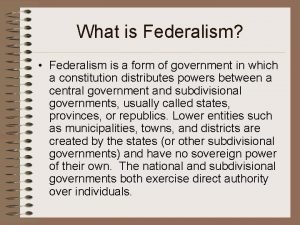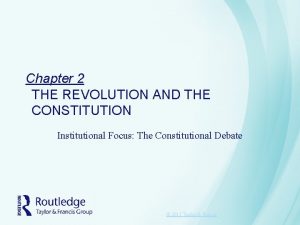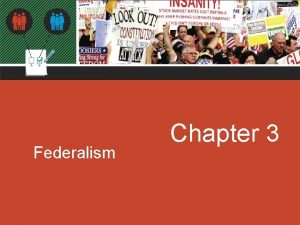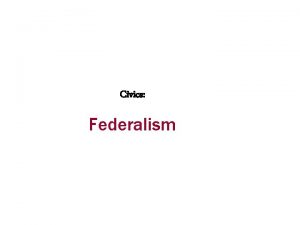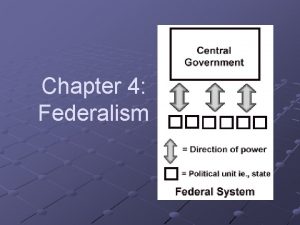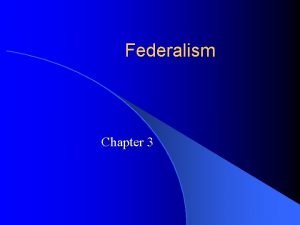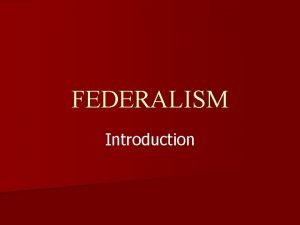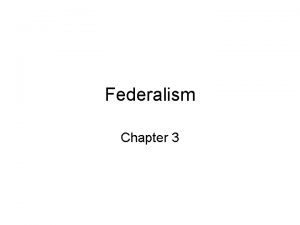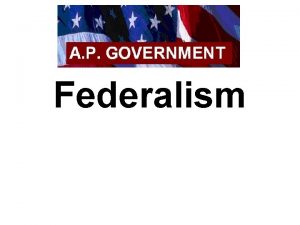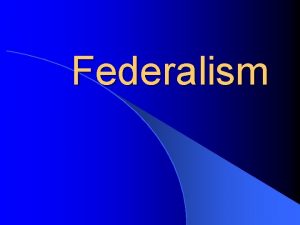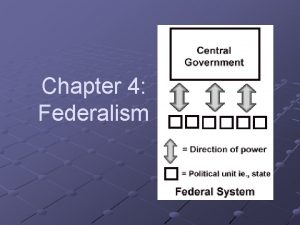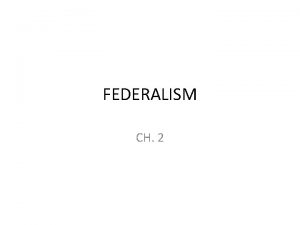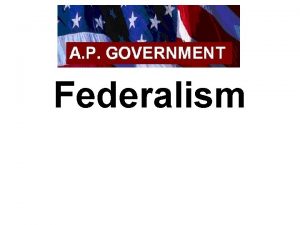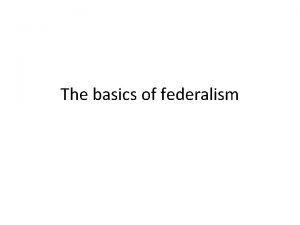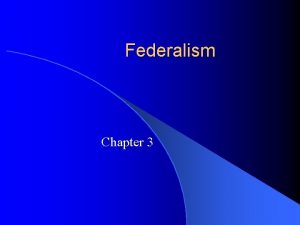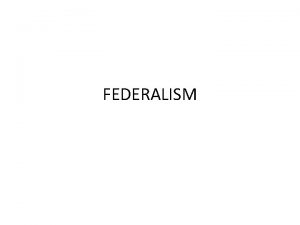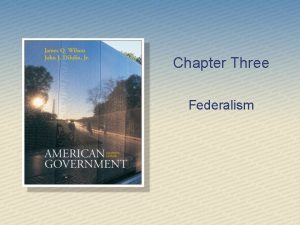Intensivseminar WS 20062007 Institute of Federalism UNIFR Fderalismus

![General Comments Negotiating [Mediating, Facilitating] is not an easy task. Why ? 1. The General Comments Negotiating [Mediating, Facilitating] is not an easy task. Why ? 1. The](https://slidetodoc.com/presentation_image/02159b00f05c507f6f60aed043180c8b/image-2.jpg)



![Informal Contacts [over time] Aim Vision of Society Who establish the mandate ? Pre-Negotiations Informal Contacts [over time] Aim Vision of Society Who establish the mandate ? Pre-Negotiations](https://slidetodoc.com/presentation_image/02159b00f05c507f6f60aed043180c8b/image-6.jpg)


![Negotiations at Institutional Level [1] Within Negotiations there are usually two sets of clauses: Negotiations at Institutional Level [1] Within Negotiations there are usually two sets of clauses:](https://slidetodoc.com/presentation_image/02159b00f05c507f6f60aed043180c8b/image-9.jpg)
![Negotiations at Institutional Level [2] There also clauses that we call Sunset Clauses and Negotiations at Institutional Level [2] There also clauses that we call Sunset Clauses and](https://slidetodoc.com/presentation_image/02159b00f05c507f6f60aed043180c8b/image-10.jpg)
![Transitional Constitutional Elts. [1] Time Limited Form of Government Transitional Gaps & contradictions Constitution Transitional Constitutional Elts. [1] Time Limited Form of Government Transitional Gaps & contradictions Constitution](https://slidetodoc.com/presentation_image/02159b00f05c507f6f60aed043180c8b/image-11.jpg)
![Transitional Constitutional Elts. [2] Transitional Const. Fundamental Issues - Three powers - Human Rights Transitional Constitutional Elts. [2] Transitional Const. Fundamental Issues - Three powers - Human Rights](https://slidetodoc.com/presentation_image/02159b00f05c507f6f60aed043180c8b/image-12.jpg)
![Definitive Constitution [1] Keys Elements coming from the Peace Agreement Transitional Const. Imperative Keys Definitive Constitution [1] Keys Elements coming from the Peace Agreement Transitional Const. Imperative Keys](https://slidetodoc.com/presentation_image/02159b00f05c507f6f60aed043180c8b/image-13.jpg)














![Four [Five] Integrative Options 1. 2. 3. 4. Create a mixed, or non-ethnic, federal Four [Five] Integrative Options 1. 2. 3. 4. Create a mixed, or non-ethnic, federal](https://slidetodoc.com/presentation_image/02159b00f05c507f6f60aed043180c8b/image-28.jpg)
![Four [Five] Integrative Options • Some experts will say this is an important element, Four [Five] Integrative Options • Some experts will say this is an important element,](https://slidetodoc.com/presentation_image/02159b00f05c507f6f60aed043180c8b/image-29.jpg)



- Slides: 32

Intensivseminar WS 2006/2007 Institute of Federalism - UNIFR "Föderalismus: ein Modell zur Konfliktbewältigung“ Prof. Thomas Fleiner - Prof. Lidija Basta Fleiner Julian Thomas Hottinger Granges-Paccot - 15 December 2006
![General Comments Negotiating Mediating Facilitating is not an easy task Why 1 The General Comments Negotiating [Mediating, Facilitating] is not an easy task. Why ? 1. The](https://slidetodoc.com/presentation_image/02159b00f05c507f6f60aed043180c8b/image-2.jpg)
General Comments Negotiating [Mediating, Facilitating] is not an easy task. Why ? 1. The nature of war determines the nature of peace. This means that the factors which produce and sustain the conflict will directly impact the ensuing peace settlement! 2. No one size fits all. 3. Each case is different 4. Terminology is not always clear.

International Community Quite often the International Community, when confronted with a conflict has two [three] options: • Exercise Political Authority • Negotiations • Or, try both…at different times

Exercise of Political Authority 1. Assistance to an interim government For exp. Afghanistan 2. Partnership with the existing occupier For exp. Namibia 3. Control of divided fractions For exp. Cambodia 4. Governorship of territory & population For exp. East Timor

Within Negotiations 1. Until about 10 years ago, the International Community usually helped negotiate ceasefires and virtual peace was built up from there. 2. Today, it is just about impossible to go down that road – you have to build a vision of society. The final optimism acceptable for all. And from there, build the «bridges» to get there. Your bridges are usually built in during the Transition.
![Informal Contacts over time Aim Vision of Society Who establish the mandate PreNegotiations Informal Contacts [over time] Aim Vision of Society Who establish the mandate ? Pre-Negotiations](https://slidetodoc.com/presentation_image/02159b00f05c507f6f60aed043180c8b/image-6.jpg)
Informal Contacts [over time] Aim Vision of Society Who establish the mandate ? Pre-Negotiations [talks about the talks] Negotiations Transition Bridges Pre-transitional Bridges Implementation

Vision of Society For exp. Federal State Constitutional building Transitional Period (3 years) What has to be done to help create a Federal State ? Institutional Building Options negotiated consensus Ideal established + pre-requisites for Transition A B

Mechanisms & Techniques Just to make things simple, there are two or three aspects that have to be looked into: 1. Within a negotiation what right do the Parties have to decide on the Nation’s future ? This is a key issue within the Institutional/Constitutional building !
![Negotiations at Institutional Level 1 Within Negotiations there are usually two sets of clauses Negotiations at Institutional Level [1] Within Negotiations there are usually two sets of clauses:](https://slidetodoc.com/presentation_image/02159b00f05c507f6f60aed043180c8b/image-9.jpg)
Negotiations at Institutional Level [1] Within Negotiations there are usually two sets of clauses: 1. Clauses that are to be included in the definitive constitution that either marks the end of the Transition – then submitted to referendum/Elections. 2. Clauses that are to be included in the Transitional Draft and usually cover this period – and once the transition is over they are dropped.
![Negotiations at Institutional Level 2 There also clauses that we call Sunset Clauses and Negotiations at Institutional Level [2] There also clauses that we call Sunset Clauses and](https://slidetodoc.com/presentation_image/02159b00f05c507f6f60aed043180c8b/image-10.jpg)
Negotiations at Institutional Level [2] There also clauses that we call Sunset Clauses and Sunrise clauses. 1. Sunset clauses are clauses that disappear once they have accomplished their task 2. Sunrise clauses are clauses that can only start fulfilling their task once a series of prerequisites have been obtained.
![Transitional Constitutional Elts 1 Time Limited Form of Government Transitional Gaps contradictions Constitution Transitional Constitutional Elts. [1] Time Limited Form of Government Transitional Gaps & contradictions Constitution](https://slidetodoc.com/presentation_image/02159b00f05c507f6f60aed043180c8b/image-11.jpg)
Transitional Constitutional Elts. [1] Time Limited Form of Government Transitional Gaps & contradictions Constitution State Institution in need of a « lifting » introducted Constitutional Fundementals: Executive, Legislative, Judiciary, defense Checks & Balances: Coalitions, Cooptation, Details on Who does What, How & When, clearly spelt Sharing of Power, Wealth, Defense.
![Transitional Constitutional Elts 2 Transitional Const Fundamental Issues Three powers Human Rights Transitional Constitutional Elts. [2] Transitional Const. Fundamental Issues - Three powers - Human Rights](https://slidetodoc.com/presentation_image/02159b00f05c507f6f60aed043180c8b/image-12.jpg)
Transitional Constitutional Elts. [2] Transitional Const. Fundamental Issues - Three powers - Human Rights - Good Governance - Defense (Army) Strong checks & Balances Cooptation Coalitions Sunset Clauses Sunrise Clauses Monitoring Implementation Transition Definitive Const. Fundamental Issues - Three powers - Human Rights - Good Governance - Defense (Army) Strong checks & Balances In need of democratic acceptancy via - Referendum - Elections
![Definitive Constitution 1 Keys Elements coming from the Peace Agreement Transitional Const Imperative Keys Definitive Constitution [1] Keys Elements coming from the Peace Agreement Transitional Const. Imperative Keys](https://slidetodoc.com/presentation_image/02159b00f05c507f6f60aed043180c8b/image-13.jpg)
Definitive Constitution [1] Keys Elements coming from the Peace Agreement Transitional Const. Imperative Keys Elements agreed upon in the Peace Agreement might go into the Definitive Const. But it must obtain democratic support

Methodology Burundi: Build on the 1992 Constitution Sudan: New elements to be added to the 1998/99 Constitution Lebanon: Coalition Mechanism built in through hardcore Negotiations. Not sealed within the Constituion.

Difference between Trans/Def Const. 1. 2. 3. 4. 5. 6. Transitional Const. Imperfect document Path to Def. Const. Confusing Elts. Heteroclite Elts. Limited in Time Very precise aim Definitive Const. 1. 2. 3. 4. Elts. CPA Respect aim CPA Democratic accept. Sign the end of Transition

Federalism: How does it fit in? Now a complex world and more complex systems needed to negotiate an agreement. • Today we will be talking of one of the elements in a conflict negotiation, which is the Federal model(s) – which are diverse – and reflect how the power-sharing should take place. • One warning: Federalism is by far not the only solution to every conflict and by far not the panacea.

Conflict Management • What is as important the institutional or constitutional building in federal models, is the acceptance of it’s logic. The will to share out power at different levels and amongst different groups. • Together with the fact, that federal contracts are probably – like most institutional set-ups - not « cast in stone » , or definitive, but demand a perpetual negotiations amongst the parties.

Conflict Management • The one last element than is important in the area of Conflict Management is the techniques used to negotiate and agreement. • Today I won’t be going into detail, but the one element I would like to strike at is: CRITERIA. This is: the need to avoid the political debate – which is always there – and concentrate on the technical aspects (e. g. Somalia)

Common Characteristics of Federalism Systems Ronald L. Watts: Comparing Federal Systems 1. Two orders of Government (Federal/State) acting directly on their citizens Federal Government States or Cantons

Common Characteristics of Federalism Systems 2. Formal Constitutional Distribution of Legislative and Executive Authority Federal Allocation of revenue Between all orders State/Cantonal Municipal

Common Characteristics of Federalism Systems 3. Representation of distinct regional view within the federal policy-making institutions Lower chamber: Congress or National Assembly Particular form of the Federal Second chamber

Common Characteristics of Federalism Systems Intergovernmental collaboration in areas that overlap 6. 4. 5. An umpire (courts etc. ) To rule on disputes between levels A supreme written constitution not unilaterally amendable and a required consent of the federal units

Power-Sharing Political Systems Power Sharing in Political Systems, within the area of Conflict Resolution, can come in all forms and shapes. The main idea is to say that: • Decision-making ideally occurs by consensus • All major groups in conflict should be included in government, and minorities, especially, are to be assured influence in policy-making on sensitive issues, which concern them (language, education).

Power-Sharing Political Systems Group Building-Block Approach The Integrative Approach

Group Building-Block • Ethnically homogenous groups form blocks of common society • Key elements: federalism and devolution of power to ethnic groups in the territory that they control; minority vetoes on sensitive issues; grand coalition cabinets; proportionality in all spheres of public life.

Five Group Building-Block opts 1. 2. 3. 4. 5. Create territorial autonomy to ethnic groups and creating confederal arrangements. Adopting constitutional provisions that ensure a minimum level of group representation at all levels of government. Adopting group proportional representation in administrative appointments, including consensusoriented decision rules in the executive. Adopting a highly proportional electoral system in a parliamentary framework; and Acknowledging group rights or corporate (nonterritorial) federalism (e. g. own language schools) in law and practice.

The Integrative Approach • Political Alliances across lines of conflict; thus creating incentives for political leaders to be moderate on divisive ethnic themes; and enhancing minority influence. • Key elements: electoral systems that encourage pre-election pacts across ethnic lines; non-ethnic federalism that diffuses points of power: public policies that promote political allegiances that transcend groups.
![Four Five Integrative Options 1 2 3 4 Create a mixed or nonethnic federal Four [Five] Integrative Options 1. 2. 3. 4. Create a mixed, or non-ethnic, federal](https://slidetodoc.com/presentation_image/02159b00f05c507f6f60aed043180c8b/image-28.jpg)
Four [Five] Integrative Options 1. 2. 3. 4. Create a mixed, or non-ethnic, federal structure, with boundaries drawn on other criteria such as natural features or economic development zones. Establishing an inclusive, centralized unitary state without further subdividing territory. Adopting an electoral system that encourages the formation of pre-election coalitions (vote pooling) across ethnic divides Devising «ethnicity-blind» public policies and laws to ensure non-discrimination on the basis of identity or religious affiliation.
![Four Five Integrative Options Some experts will say this is an important element Four [Five] Integrative Options • Some experts will say this is an important element,](https://slidetodoc.com/presentation_image/02159b00f05c507f6f60aed043180c8b/image-29.jpg)
Four [Five] Integrative Options • Some experts will say this is an important element, while I am not sure of how good the idea is: 5. Adopting winner-take-all but ethnically diverse executive, legislative, and administrative decision-making bodies.

Three Lessons Learned 1. For Power Sharing to work, there must be a strong core of moderates – both political elites and civil society – that seeks coexistence. Moderates must be able to withstand pressures by extremist politicians and public.

Three Lessons Learned 2. More important, in my opinion, than the actual form of power sharing (group building-block or integrative) is the extent to which agreement to create power-sharing system is the result of goodfaith bargaining and negotiation.

Three Lessons Learned 3. Power-sharing systems work best when they are a temporary measure to build confidence (wear down the conflict) until more permanent structures can be adopted.
 Rita raemy
Rita raemy Universität fribourg psychologie
Universität fribourg psychologie Creative federalism definition
Creative federalism definition Pragmatic federalism definition
Pragmatic federalism definition Dual federalism
Dual federalism American government chapter 4
American government chapter 4 Federalism venn diagram
Federalism venn diagram Cooperative federalism
Cooperative federalism Lausania
Lausania Dual federalism definition ap gov
Dual federalism definition ap gov Problems with the articles of confederation
Problems with the articles of confederation Federalism
Federalism Fiscal federalism definition ap gov
Fiscal federalism definition ap gov Dual federalism
Dual federalism Dual federalism
Dual federalism Difference between regionalism and federalism in a sentence
Difference between regionalism and federalism in a sentence Chapter 4 federalism
Chapter 4 federalism Dual federalism
Dual federalism How does the separation of powers guard against tyranny
How does the separation of powers guard against tyranny Federalism powers divided
Federalism powers divided Concurrent powers
Concurrent powers Whats fiscal federalism
Whats fiscal federalism Conflicted federalism definition
Conflicted federalism definition Basic premise of federalism
Basic premise of federalism Constitutional underpinnings definition
Constitutional underpinnings definition Federalism
Federalism Cooperative federalism
Cooperative federalism Two types of federalism
Two types of federalism Federalism
Federalism Six basic principles of the constitution worksheet
Six basic principles of the constitution worksheet Advantages of federalism
Advantages of federalism Picket fence federalism definition
Picket fence federalism definition Anti federalists beliefs
Anti federalists beliefs


